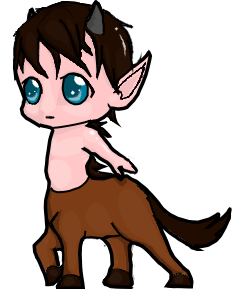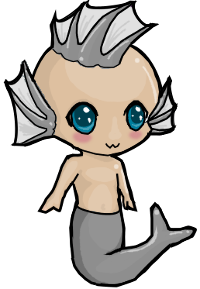○Species Information○○The Common Water Nymph○Overview
Water nymphs are a relatively unknown but common marine mammal. Water nymphs are consistent in size, reaching 11 inches from the cranial dorsal (
Cranial dorsal?... is that a word?... I guess that's a word now... I made up a species why can't I make up a word?) to the tip of their tail. Water nymphs are typically found in tropical shallows and prefer temperatures between 75 and 82 degrees, and thrive in high wattage tanks (4wpg and up).
General anatomy
Average water nymphs have four basic fins. The fin running along the top of it's head helps the nymph to balance when swimming, while the two fins (located on either side of the head) keep oxygen rich water running across the nymphs face and gills (located behind the fins). Water nymphs have a labyrinth (an aquatic lung), because the water they prefer is usually oxygen deficient. Adding an air pump to a water nymph may aid other items, such as increasing the number of fry or (on some occasions) they may steal an item for you!
Behavior
Water nymphs are a social creature, often found in small shoals upwards of 6 nymphs. Studies show that water nymphs have the mental capacity of a 3 year old human, at this level of intelligence the need for food is often met, leaving the water nymphs to get into their own trouble. They are fun loving and make games of nearly everything.
Spawning
Spawning is too time consuming for water nymphs. With so many games for them to play, chemicals are required to encourage nymphs to mate. When nymphs spawn, they can produce 1 to 3 fry.
○The Centaur Nymph○Overview
The centaur nymph are a proud land dwelling nymph. Reaching 13 inches from head to hooves and weighing close to 8 pounds. Centaur nymphs are difficult to find, and because of this it is hard to say where they can be found. Being the mortal enemies of water nymphs (for reasons that neither species will disclose

... I'll let you know if they every tell me...), they are never too far away.
General Anatomy
The centaur nymph has a messy mane that runs the length of it's body and feeds into it's tail, often sticking to it's forehead from excessive play. The bottom half of the centaur nymph consist mainly of muscle, while the upper body resembles that of a human. Centaur nymphs are very dangerous for their small size, armed with two sharp horns and powerful hooves (not that anything other than -small- bugs need to fear being stepped on lol).
Behavior
These nymphs are highly intelligent, playing hard and rambunctiously with members of their herd. However, centaur nymphs are much more guarded and prideful around people than water nymphs and for that reason are very difficult to catch.
Mating
Little is known about breeding centaur nymphs, because so few have been held in captivity. Breeding chemicals can sometimes be given to them successfully, but it is not uncommon for the nymph to refuse the bitter chemical.


 .
.  [/strike]
[/strike]










 x2
x2 x2
x2